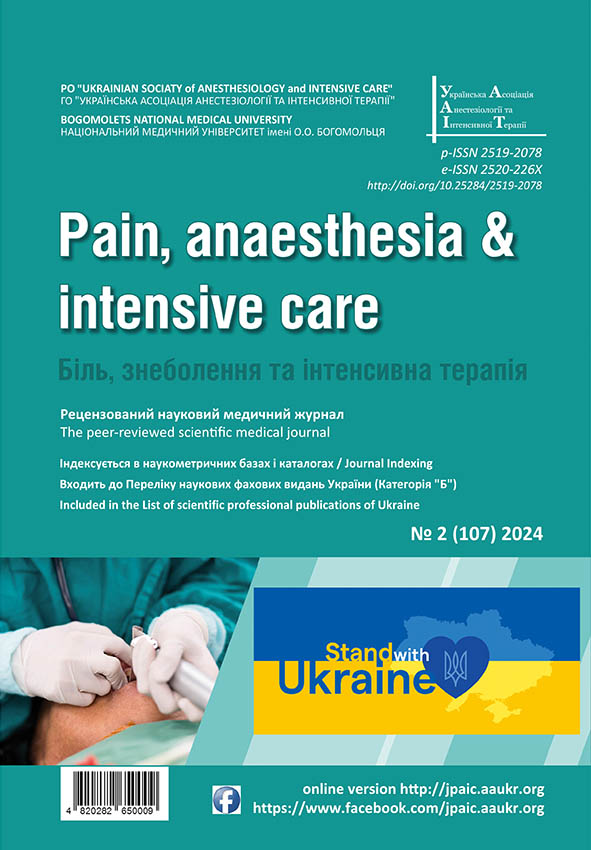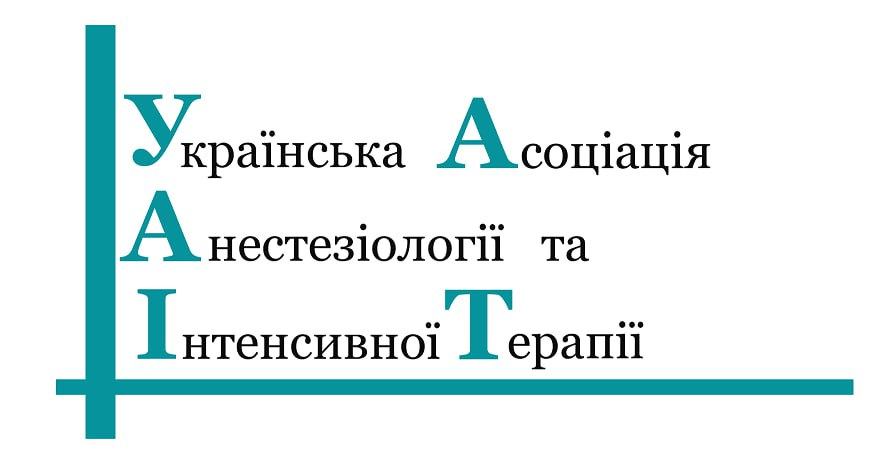МІСЦЕ МУЛЬТИМОДАЛЬНОЇ АНЕСТЕЗІЇ/ АНАЛГЕЗІЇ В СУЧАСНОМУ ПЕРІОПЕРАЦІЙНОМУ ВЕДЕННІ ПАЦІЄНТІВ (ОГЛЯД ЛІТЕРАТУРИ)
DOI:
https://doi.org/10.25284/2519-2078.2(107).2024.308305Ключові слова:
опіоїди, безопоїдна анестезія, малопіоїдна анестезія, періопераційний період, парацетамол, дексмедетомідин, нестероїдні протизапальні препарати, дексаметазон, лідокаїн, кетамінАнотація
Одним з основних напрямків розвитку сучасної анестезіології є управління періопераційним болем з метою обмеження негативних наслідків інтра- та післяопераційного больового синдрому. Традиційно опіоїди відігравали центральну роль у збалансованій анестезії, оскільки допомагали контролювати ноцицепцію та оптимізували гемодинаміку, але мають багато побічних ефектів, які подовжують перебування пацієнта в лікарні і погіршують післяопераційний перебіг, що збільшує вартість медичної допомоги. Встановлено, що застосування безопіоїдної (БОА) або малоопіоїдної анестезії (МОА) з використанням парацетамолу, дексмедетомідину, нестероїдних протизапальних препаратів, дексаметазону, лідокаїну та кетаміну зменшує або уникає вживання опіоїдів у пацієнтів у періопераційному періоді.
Метою цього систематичного огляду є вивчення наявних рандомізованих контрольованих досліджень щодо ноцицептивних стратегій у періопераційному періоді та їхнє оцінювання на підставі як суб’єктивних, так і об’єктивних показників ефективності, безпеки, а також економічних витрат. Проведено систематичний пошук даних по базах MEDLINE, ISI Web of Science, PubMed, Scopus, Google Scholar, Cochrane Database of Systematic Reviews та публікацій у фахових виданнях України за 2013–2023 рр. Пошук проводили за такими ключовими словами: опіоїди, безопоїдна анестезія, малопіоїдна анестезія, періопераційний період, вагітність, парацетамол, дексмедетомідин, нестероїдні протизапальні препарати, дексаметазон, лідокаїн, кетамін.
Висновок. Стратегії безопіоїдної і малоопіоїдної анестезії/аналгезії дозволяють підвищити якість лікування і безпеку пацієнтів, але потребують подальшого ретельного дослідження.
Посилання
Garimella V., Cellini C. Postoperative pain control. Clin Colon Rectal Surg. 2013;26(3):191-6. doi: 10.1055/s-0033-1351138.
 |
| 
Baratta JL, Schwenk ES, Viscusi ER. Clinical consequences of inadequate pain relief: barriers to optimal pain management. Plast Reconstr Surg. 2014;134(4 Suppl 2):15S-21S. doi: 10.1097/PRS.0000000000000681.
 |
| 
Chou R, Gordon DB, de Leon-Casasola OA, Rosenberg JM, Bickler S, Brennan T, et al. Management of postoperative pain: a clinical practice guideline from the American Pain Society, the American Society of Regional Anesthesia and Pain Medicine, and the American Society of Anesthesiologists' Committee on Regional Anesthesia, Executive Committee, and Administrative Council. J. Pain. 2016;17(2):131-57. doi: 10.1016/j.jpain.2015.12.008.
 |
|  |
| 
Egan TD. Are opioids indispensable for general anaesthesia? British journal of anaesthesia. 2019.Jun;122(6):e127-e135.doi: 10.1016/j.bja.2019.02.018.
 |
| 
White P.F. The role of non-opioid analgesic techniques in the management of pain after ambulatory surgery. // Anesth Analg 2002; 94: 577-85.
 |
| 
Pizzi L., Toner R., Foley K. et al. Relationship between potential opioid-related adverse effects and hospital length of stay in patients receiving opioids after orthopedic surgery // Pharmacotherapy. 2012. Vol. 32. Iss. 6. P. 502-514.
 |
| 
Lavand’homme P., Estebe JP. Opioid-free anesthesia a different regard to anesthesia practic // Current Opinion in Anaesthesiology: October 2018 – Volume 31 – Issue 5 – p 556-561 doi: 10.1097/ACO.0000000000000632;
 |
| 
Aich A, Gupta P, Gupta K. Could peri-operative opioid use increase the risk of cancer progression and metastases? // Int. Anesthesiol. Clin. 2016;54:e1. doi: 10.1097/AIA.0000000000000112.
 |
| 
Lee J, Hu HM, Edelman AL, Brummett CM, Englesbe MJ, Waljee JF, et al. New persistent opioid use among patients with cancer after curative-intent surgery. // J Clin Oncol Off J Am Soc Clin Oncol. 2017;35:4042–4049. doi: 10.1200/JCO.2017.74.1363.
 |
| 
Liu Q., Gold M. Opioid induced loss of local anesthetic potency in the rat sciatic nerve // Anesthesiology. 2016. Vol. 125. Iss. 4. P. 755-764.
 |
| 
Gupta K, Nagappa M, Prasad A, Abrahamyan L, Wong J, Weingarten TN, et al. Risk factors for opioid-induced respiratory depression in surgical patients: a systematic review and meta-analyses. BMJ Open. 2018;8:e024086. doi: 10.1136/bmjopen-2018-024086.
 |
| 
Shah A, Hayes CJ, Martin BC. Characteristics of initial prescription episodes and likelihood of long-term opioid use—United States, 2006–2015. MMWR Morb Mortal Wkly Rep. 2017;66:265. doi: 10.15585/mmwr.mm6610a1.
 |
| 
Hakim KY, Wahba WZ. Opioid-free total intravenous anesthesia improves postoperative quality of recovery after ambulatory gynecologic laparoscopy. Anesth Essays Res 2019; 13: 199-203.

Tufanogullari B, White PF, Peixoto MP, Kianpour D, Lacour T, Griffi n J, et al. Dexmedetomidine infusion during laparoscopic bariatric surgery: The effect on recovery outcome variables. Anesth Analg 2008;106:1741-8.
 |
|  |
| 
Кamdar N.V., Hoftman N., Rahman S., et al. Opioid-Free Analgesia in the Era of Enhanced Recovery After Surgery and the Surgical Home: Implications for Postoperative Outcomes and Population Health. Anesth Analg. 2017; 125:1089-1091
 |
| 
Boysen PG 2nd, Pappas MM, Evans B.An Evidence-Based Opioid-Free Anesthetic Technique to Manage Perioperative and Periprocedural Pain. Ochsner J. 2018 Summer;18(2):121-125. doi: 10.31486/toj.17.0072.
 |
| 
Beloeil Н Opioid-free anesthesia Best Practice & Research Clinical Anaesthesiology Volume 33, Issue 3, September 2019, Pages 353-360
 |
| 
Gupta S. ,Mohta A., Gottumukkala V. Opioid-free anesthesia—caution for a one- size-fi ts-all approach Perioperative Medicine (2020) 9:16 https://doi.org/10.1186/s13741-020-00147-3.

Frauenknecht J, Kirkham K, Jacot-Guillarmod A, Albrecht E. Analgesic impact of intra-operative opioids vs. opioid-free anaesthesia: a systematic review and meta-analysis. Anaesthesia. 2019;74:651–662. doi:10.1111/anae.14582.
 |
| 
Lee LA, Caplan RA, Stephens LS, Posner KL, Terman GW, Voepel-Lewis T, et al. Postoperative opioid-induced respiratory depression a closed claims analysis. J Am Soc Anesthesiol. 2015;122:659–665. doi: 10.1097/ALN.0000000000000564.
 |
| 
Weingarten TN, Chong EY, Schroeder DR, Sprung J. Predictors and outcomes following naloxone administration during phase I anesthesia recovery. J Anesth. 2016;30:116–122. doi: 10.1007/s00540-015-2082-0.
 |
| 
Cronin-Fenton DP, Heide-Jørgensen U, Ahern TP, Lash TL, Christiansen PM, Ejlertsen B, et al. Opioids and breast cancer recurrence: a Danish populationbased cohort study. Cancer. 2015;121:3507–3514. doi: 10.1002/cncr.29532.
 |
| 
Diaz-Cambronero O, Mazzinari G, Cata JP. Perioperative opioids and colorectal cancer recurrence: a systematic review of the literature. Pain Manag. 2018;8:353–361. doi: 10.2217/pmt-2018-0029.
 |
| 
Oh TK, Jeon JH, Lee JM, Soo Kim M, Kim JH, Cho H, et al. Investigation of opioid use and long-term oncologic outcomes for non-small cell lung cancer patients treated with surgery. PloS One. 2017;12:e0181672. doi: 10.1371/journal.pone.0181672.
 |
| 
Humphreys K. Avoiding globalisation of the prescription opioid epidemic. Lancet. 2017;390:437–439. doi: 10.1016/S0140-6736(17)31918-9.
 |
| 
Brandal D, Keller MS, Lee C, Grogan T, Fujimoto Y, Gricourt Y, et al. Impact of enhanced recovery after surgery and opioid-free anesthesia on opioid prescriptions at discharge from the hospital: a historical-prospective study. Anesth Analg. 2017;125:1784–1792. doi: 10.1213/ANE.0000000000002510.
 |
| 
Овечкин А.М., Безопиоидная аналгезия в хирургии : от теории к практике [Электронный ресурс] / Овечкин А.М., Яворовский А.Г. – М.: ГЭОТАР-Медиа, 2019. – 240 с.
B. Е. Аваков, Р. М. Сайпов, Т. М. Исомов, Г. М. Бозоров / Парацетамол в послеоперационной аналгезии // Травма. 2016. № 1. С. 28-32.
Кобеляцкий Ю.Ю. Расширение возможностей периоперационной анальгезии. Медицина неотложных состояний. 2012. № 2 (41). C. 7 – 12.
S. Arici, A. Gurbet, G. Türker [et al.] Preemptive analgesic effects of intravenous paracetamol in total abdominal hysterectomy // Agri. 2009. Apr, Vol. 21 (2). Р. 54-61.
 |
| 
Ничитайло М.Е., Булик Л.М. Инфулган – оптимальный аналгетический препарат для применения в лапароскопической терапии. Клінічна хірургія. 2015. № 6. С. 9-10.
Савустьяненко А.В. Внутривенная форма парацетамола: опыт мировых клиник за последние 5 лет. Медицина неотложных состояний. 2014. № 7(62). С. 37-44
Intravenous acetaminophen reduces postoperative nausea and vomiting: Asystematic review and meta-analysis / C. C. Apfela, A. Turanc, K. Souzaa [et al.] // PAIN. 2013. № Vol. 154. Р. 677–689.
 |
| 
De Oliveira G.S. Jr.1, Castro-Alves L.J., McCarthy R.J. Single-dose systemic acetaminophen to prevent postoperative pain: a meta-analysis of randomized controlled trials. Clin. J. Pain. 2015 Jan. № 31(1). Р. 86-93. doi: 10.1097/AJP.0000000000000081.
 |
| 
Ricciotti E, FitzGerald GA. Prostaglandins and infl ammation. Arterioscler Thromb Vasc Biol. 2011;31(5):986-1000. doi: 10.1161/ATVBAHA.110.207449. PMID: 21508345; PMCID: PMC3081099.
 |
| 
Bacchi S, Palumbo P, Sponta A, Coppolino MF. Clinical pharmacology of non-steroidal anti-infl ammatory drugs: a review. Antiinfl amm Antiallergy Agents Med Chem. 2012;11(1):52-64. doi: 10.2174/187152312803476255.
 |
| 
Auriel E, Regev K, Korczyn AD. Nonsteroidal anti-infl ammatory drugs exposure and the central nervous system. Handb Clin Neurol. 2014;119:577-84. doi: 10.1016/B978-0-7020-4086-3.00038-2.
 |
| 
Gallelli L, Galasso O, Falcone D, Southworth S, Greco M, Ventura V, et al. The effects of nonsteroidal anti-infl ammatory drugs on clinical outcomes, synovial fl uid cytokine concentration and signal transduction pathways in knee osteoarthritis. A randomized open label trial. Osteoarthritis Cartilage. 2013;21(9):1400-8. doi: 10.1016/j.joca.2013.06.026.
 |
| 
А.М. ОВЕЧКИН, С.В. СОКОЛОГОРСКИЙ , М.Е. ПОЛИТОВ БЕЗОПИОИДНАЯ АНЕСТЕЗИЯ И АНАЛЬГЕЗИЯ – ДАНЬ МОДЕ ИЛИ ВЕЛЕНИЕ ВРЕМЕНИ? Novosti Khirurgii. 2019 Nov-Dec; Vol 27 (6): 700-715 doi: 10.18484/2305-0047.2019.6.700

Kotagal M, Hakkarainen TW, Simianu VV, Beck SJ, Alfonso-Cristancho R, Flum DR. Ketorolac Use and Postoperative Complications in Gastrointestinal Surgery. Ann Surg. 2016 Jan;263(1):71-5. doi: 10.1097/SLA.0000000000001260
 |
| 
Davidson JS, Turner K. Ketorolac does not increase perioperative bleeding: a meta-analysis of randomized controlled trials. Plast Reconstr Surg [Internet]. 2015 [cited 2019 Jan 3];135(3):648e–649e. Available from: doi: https://doi.org/10.1097/PRS.0000000000001046.
 |
| 
Gaskell H, Derry S, Wiffen PJ, Moore RA. Single dose oral ketoprofen or dexketoprofen for acute postoperative pain in adults. Cochrane Database Syst Rev [Internet]. 2017 [cited 2019 Sept 9];5(5):CD007355. Available from: doi: https://doi.org/10.1002/14651858.CD007355.pub3
 |
| 
Yurtlu S, Hanci V, Kargi E, et al. The analgesic effect of dexketoprofen when added to lidocaine for intravenous regional anaesthesia: a prospective, randomized, placebo-controlled study. J Int Med Res. 2011;39(5):1923-31. doi: 10.1177/147323001103900537.
 |
| 
Walczak JS. Analgesic properties of dexketoprofen trometamol. Pain Manag. 2011;1(5):409-16. doi: 10.2217/pmt.11.42.
 |
| 
Zippel H, Wagenitz A. Comparison of the efficacy and safety of intravenously administered dexketoprofen trometamol and ketoprofen in the management of pain after orthopaedic surgery: A multicentre, double-blind, randomised, parallel-group clinical trial. Clin Drug Investig. 2006;26(9):517-28. doi: 10.2165/00044011-200626090-00005.
 |
| 
Moore RA, Barden J. Systematic review of dexketoprofen in acute and chronic pain. BMC Clin Pharmacol. 2008;8:11. doi: 10.1186/1472-6904-8-11. PMID: 18976451; PMCID: PMC2585070.
 |
| 
Afonso J., Reis F.. Dexmedetomidine: current role in anesthesia and intensive care. Revista Brasileira de Anestesiologia. 2012 Jan-Feb. № 62 (1). Р. 118-33. doi: 10.1016/S0034-7094(12)70110-1.
 |
| 
Gerresheim G., Schwemmer U. Dexmedetomidine. Anaesthesist. 2013. № 62 (8) . P. 74.
 |
| 
Le Bot A, Michelet D, Hilly J, Maesani M, Dilly MP, Brasher C, Mantz J, Dahmani S. Efficacy of intraoperative dexmedetomidine compared with placebo for surgery in adults: a meta-analysis of published studies. Minerva Anestesiol. 2015 Oct;81(10):1105-17. doi: 10.1007/s40122-016-0045-2
 |
| 
Davy A, Fessler J, Fischler M, LE Guen M. Dexmedetomidine and general anesthesia: a narrative literature review of its major indications for use in adults undergoing non-cardiac surgery. Minerva Anestesiol. 2017 Dec;83(12):1294-1308. doi: 10.23736/ S0375-9393.17.12040-7
 |
| 
Grewal A. Dexmedetomidine: New avenues. J Anaesthesiol Clin Pharmacol. 2011 Jul;27(3):297-302. doi: 10.4103/0970-9185.83670
 |
| 
Kimura M, Saito S, Obata H. Dexmedetomidine decreases hyperalgesia in neuropathic pain by increasing acetylcholine in the spinal cord. Neurosci Lett. 2012 Oct 31;529(1):70-74. doi: 10.1016/j.neulet.2012.08.008
 |
| 
Schnabel A, Meyer-Frießem CH, Reichl SU, Zahn PK, Pogatzki-Zahn EM. Is intraoperative dexmedetomidine a new option for postoperative pain treatment? A meta-analysis of randomized controlled trials. Pain. 2013 Jul;154(7):1140-49. doi: 10.1016/j.pain.2013.03.029
 |
| 
Tkachenko R, Zaychenko S. INFLUENCE OF DIFFERENT TYPES OF ANESTHESIA FOR LAPAROSCOPIC HYSTERECTOMY ON THE DYNAMICS OF STRESS HORMONES //«EUREKA: Health Sciences» (2021), Number 1. P 64 – 71, DOI: 10.21303/2504-5679.2021.001598
Marret E, Rolin M, Beaussier M, Bonnet F. Meta-analysis of intravenous lidocaine and postoperative recovery after abdominal surgery. British Journal of Surgery. 2008;95(11):1331-1338. https://doi.org/10.1002/bjs.6375
 |
| 
Lauretti G. Mechanisms of analgesia of intravenous lidocaine. Brazilian Journal of Anesthesiology. 2008;58(3):280-286.
 |
| 
Linnerup NB, Biering-Sørensen F et al. Intravenous lidocaine relieves spinal cord injury pain: a randomized controlled trial. Anesthesiology. 2005;102(5):1023-1030.
 |
| 
Abelson K, Hoglund A. Intravenously administered lidocaine in therapeutic doses increases the intraspinal release of acetylcholine in rats. Neuroscience Letters. 2002;317(2):93-96.
 |
| 
Hollmann MW, Ritter CH, Henle P, de Klaver M, Kamatchi GL, Durieux ME. Inhibition of m3 muscarinic acetylcholine receptors by local anaesthetics. British Journal of Pharmacology. 2001;133(1):207-216. https://doi.org/10.1038/sj.bjp.0704040
 |
| 
Cohen S, Mao J. Is the analgesic effect of systemic lidocaine mediated through opioid receptors? Acta Anaesthesiologica Scandinavica. 2003;47(7):910-911.
 |
| 
Nagy I, Woolf C. Lignocaine selectivity reduces C fibre evoked neuronal activity in rat spinal cord in vitro by decreasing N-methyl-D-aspartate and neurokinin receptor-mediated postsynaptic depolarizations; implications for the development of novel centrally acting analgesics. Pain. 1996;64:59-70.
 |
| 
McCarthy G, Megalla S, Habib A. Impact of intravenous lidocaine infusion on postoperative analgesia and recovery from surgery. A systematic review of randomized controlled trials. Drugs. 2010;70(9):1149-1163. https://doi.org/10.2165/10898560-000000000-00000.
 |
| 
De Kock M, Lavand'homme P, Waterloos H. 'Balanced analgesia' in the perioperative period: is there a place for ketamine?. Pain. 2001;92(3):373-80. doi: 10.1016/s0304-3959(01)00278-0.
 |
| 
Wu L, Huang X, Sun L. The efficacy of N-methyl-D-aspartate receptor antagonists on improving the postoperative pain intensity and satisfaction after remifentanil-based anesthesia in adults: a meta-analysis. J Clin Anesth. 2015;27(4):311-24. doi: 10.1016/j.jclinane.2015.03.020.
 |
| 
Barreveld AM, Correll DJ, Liu X, Max B, McGowan JA, Shovel L, et al. Ketamine decreases postoperative pain scores in patients taking opioids for chronic pain: results of a prospective, randomized, double-blind study. Pain Med. 2013;14(6):925-34. doi:10.1111/pme.12086.

Chaparro LE, Smith SA, Moore RA, Wiffen PJ, Gilron I. Pharmacotherapy for the prevention of chronic pain after surgery in adults. Cochrane Database Syst Rev 2013 [cited 2019 Nov 9];2013(7):CD008307. Available from: https://doi.org/10.1002/14651858.CD008307.pub2.
 |
| 
McCartney CJ, Sinha A, Katz J. A qualitative systematic review of the role of N-methyl-D-aspartate receptor antagonists in preventive analgesia. Anesth Analg. 2004 May;98(5):1385-400. doi: 10.1213/01.ane.0000108501.57073.38.
 |
| 
Dahmani S, Michelet D, Abback P, Wood C, Brasher C, Nivoche Y, et al. Ketamine for perioperative pain management in children: a meta-analysis of published studies. Paediatr Anaesth. 2011;21(6):636-52. doi: 10.1111/j.1460-9592.2011.03566.x.8
Gorlin AW, Rosenfeld DM, Ramakrishna H. Intravenous sub-anesthetic ketamine for perioperative analgesia. J Anaesthesiol Clin Pharmacol. 2016;32(2):160-7. doi: 10.4103/0970-9185.182085.
 |
| 
Laskowski K, Stirling A,. McKay WP,. Lim HJ. A systematic review of intravenous ketamine for postoperative analgesia. Can J Anaesth. 2011;58(10):911-23. doi: 10.1007/s12630-011-9560-0.
 |
| 
Vosoughin M, Mohammadi S, Dabbagh A. Intravenous ketamine compared with diclofenac suppository in suppressing acute postoperative pain in women undergoing gynecologic laparoscopy. J Anesth. 2012;26(5):732-7. doi: 10.1007/s00540-012-1399-1.
 |
| 
Siddiqui KM, Khan FA. Effect of preinduction low-dose ketamine bolus on intra operative and immediate postoperative analgesia requirement in day care surgery: A randomized controlled trial. Saudi J Anaesth. 2015;9(4):422-7.
 |
| 
Mion G. Is it time to cease the single low-dose ketamine injection at induction of anesthesia? Acta Anaesthesiol Scand. 2017;61(10):1377-8. doi: 10.1111/aas.12996
 |
| 
Dahl V, Ernoe PE, Steen T, Raeder JC, White PF. Does ketamine have preemptive effects in women undergoing abdominal hysterectomy procedures? Anesth Analg. 2000;90(6):1419-22. doi: 10.1097/00000539-200006000-00031
 |
| 
Klohs MW, Draper MD, Petracek FJ, Ginzel KH, R ON. Benzoxazocines: a new chemical class of centrally acting skeletal muscle relaxants. ArzneimittelForschung. 1972 Jan;22(1):132.
 |
| 
Verleye M., Andre N., Heulard I. et al. Nefopam blocks voltage sensitive sodium channels and modulates glutamatergic transmission in rodents // Brain Res. 2004. Vol. 1013. P. 249-255.
 |
| 
Kapfer B, Alfonsi P, Guignard B, Sessler DI, Chauvin M. Nefopam and Ketamine Comparably Enhance Postoperative Analgesia. Anesthesia & Analgesia 2005 Jan;100(1):169– 74. https://doi.org/10.1213/01.ane.0000138037.19757.ed
 |
| 
Tirault M, Derrode N, Clevenot D, Rolland D, Fletcher D, Debaene B. The Effect of Nefopam on Morphine Overconsumption Induced by Large-Dose Remifentanil During Propofol Anesthesia for Major Abdominal Surgery. Anesthesia & Analgesia 2006 Jan;102(1):110–7. https://doi.org/10.1213/01.ane.0000181103.07170.15
 |
| 
Cho SY, Park AR, Yoon MH, Lee HG, Kim WM, Choi JI. Antinociceptive Effect of Intrathecal Nefopam and Interaction with Morphine in Formalin-Induced Pain of Rats. The Korean Journal of Pain Korean Pain Society; 2013;26(1):14. https://doi.org/10.3344/ kjp.2013.26.1.14
 |
| 
Kim KH, Abdi S. Rediscovery of Nefopam for the Treatment of Neuropathic Pain. The Korean Journal of Pain Korean Pain Society; 2014;27(2):103. https://doi.org/10.3344/kjp.2014.27.2.103
 |
| 
Delage N, Maaliki H, Beloeil H, Benhamou D, Mazoit J-X. Median Effective Dose (ED50) of Nefopam and Ketoprofen in Postoperative Patients. Anesthesiology 2005 Jun;102(6):1211–6. https://doi.org/10.1097/00000542–200506000–00022
 |
| 
McLintock T., Kenny G., Howie J. Assessment of the analgesic efficacy of nefopam hydrochloride after upper abdominal surgery: a study using patient controlled analgesia // Br. J. Surg. 1988. Vol. 75. P. 779-781
 |
| 
Mok MS, Lippmann M, Steen SN. Comparison of intravenous nefopam versus morphine for the relief of post-operative pain. In clinical pharmacology & therapeutics 1979 Jan 1 (Vol. 25, No. 2, pp. 237–238
##submission.downloads##
Опубліковано
Як цитувати
Номер
Розділ
Ліцензія

Ця робота ліцензується відповідно до Creative Commons Attribution-NonCommercial 4.0 International License.
Автори, які публікуються у цьому журналі, погоджуються з наступними умовами:
a. Автори залишають за собою право на авторство своєї роботи та передають журналу право першої публікації цієї роботи на умовах ліцензії Creative Commons Attribution-NonCommercial 4.0 International License, котра дозволяє іншим особам вільно розповсюджувати опубліковану роботу з обов'язковим посиланням на авторів оригінальної роботи та першу публікацію роботи у цьому журналі.
b. Автори мають право укладати самостійні додаткові угоди щодо неексклюзивного розповсюдження роботи у тому вигляді, в якому вона була опублікована цим журналом (наприклад, розміщувати роботу в електронному сховищі установи або публікувати у складі монографії), за умови збереження посилання на першу публікацію роботи у цьому журналі.
c. Політика журналу дозволяє і заохочує розміщення авторами в мережі Інтернет (наприклад, у сховищах установ або на особистих веб-сайтах) рукопису роботи, як до подання цього рукопису до редакції, так і під час його редакційного опрацювання, оскільки це сприяє виникненню продуктивної наукової дискусії та позитивно позначається на оперативності та динаміці цитування опублікованої роботи (див. The Effect of Open Access).








